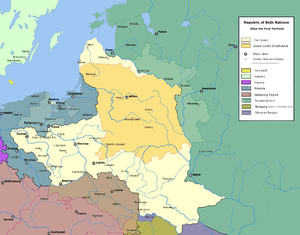Partition Sejm
In the late 17th and early 18th centuries the Polish-Lithuanian Commonwealth was reduced from the status of a major European power to that of a Russian protectorate (or vassal or satellite state).
Russian tsars effectively chose Polish-Lithuanian monarchs utilizing the "free elections" and decided the outcome of much of Poland's internal politics.
As Austria had annexed 13 towns in the Hungarian Szepes region in 1769 (violating the Treaty of Lubowla), Catherine II of Russia and her advisor General Ivan Chernyshyov suggested to Henry that Prussia claim some Polish land, such as Ermland.
[3] Austrian statesman Wenzel Anton Graf Kaunitz counter-proposed that Prussia take lands from Poland in return for relinquishing Silesia to Austria, but this plan was rejected by Frederick.
Further, the Russian-supported Polish king, Stanisław August Poniatowski, was seen as both weak and too independent-minded; eventually the Russian court decided that the usefulness of Poland as a protectorate had diminished.
[5] The three powers officially justified their actions as a compensation for dealing with a troublesome neighbor and restoring order in Poland through military intervention (the Bar Confederation provided a convenient excuse); in fact all three were interested in territorial gains.
[7] Only token objections were however raised by Austria,[5] which would have instead preferred to receive more Ottoman territories in the Balkans, a region which for a long time had been coveted by the Habsburgs.
An attempt of Bar Confederates to kidnap King Poniatowski on 3 November 1771 gave the three courts a pretext to showcase the "Polish anarchy" and the need for its neighbors to step in and "save" the country and its citizens.
[7] Early in August Russian, Prussian and Austrian troops simultaneously entered the Commonwealth and occupied the provinces agreed upon among themselves.
[8] When no help was forthcoming and the armies of the combined nations occupied Warsaw to compel by force of arms the calling of the assembly, no alternative was available save passive submission to their will.
[7][8] Warsaw was de facto a garrison of the foreign powers, with their forces commanded by the Austrian (or Russian, sources vary) general Abram Romanius (Abraham).
[8][9][12][13] The marshals of the Sejm were Adam Poniński, one of the nobles in Russian service, for the Crown of Poland, and Michał Hieronim Radziwiłł for the Grand Duchy of Lithuania.
[15] Out of those, Rejtan's gesture – in which he was said to have barred the doors, torn his shirt, and asked other deputies to murder him rather than Poland – became widely known, and was immortalized in a painting by Jan Matejko.
[16] By 24 April the few vocal opponents, such as Rejtan, had lost, the confederation was joined by the King and the Sejm elected a committee of thirty to deal with the various matters presented (primarily the partitioners' demands, but also some reforms to the government).
[8] Despite some protests, on 18 September 1773, the Committee formally signed the treaty of cession, renouncing all claims of the Commonwealth to the occupied territories.
[7] The senators who protested were threatened by the Russians (represented by Ambassador Otto von Stackelberg), who declared that in the face of refusal the whole capital of Warsaw would be destroyed.
The Partition cut off the Commonwealth's access to the Baltic Sea, and the state had no choice but to accept the high tariffs imposed by Prussia.
[21][22] The Sejm also created two notable institutions: the Permanent Council, a main governmental body in continuous operation, and the Commission of National Education.
[9] The council was intended by the partitioners to be an institution easier to control than the unruly Sejms, and indeed it remained under the influence of the Russian Empire.
[8][9] The council, with committees (ministries) on Foreign Affairs, Treasury, Defense, Justice and the Interior (Police), was able to interpret existing laws in the sphere of administration, and provided the Commonwealth with a continuous governing body that operated between the Sejms and was not affected by the liberum veto.
Various fraudulent deals were made that channeled funds intended for government institutions, such as the Commission of National Education, to the pockets of the deputies and their allies.



